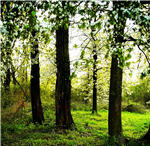In his State of the Union address, President Barack Obama praised the potential of the country's tremendous supply of natural gas buried in shale. He echoed the recommendations for safe extraction made by an advisory panel that included Stanford University geophysicist Mark Zoback. The panel made 20 recommendations for regulatory reform, some of which go well beyond what the president mentioned in his address.
As the interest in environmentally responsible business practices grows globally, researchers are interested in how that interest translates into consumer sales. Researchers from the University of Missouri (MU) have found that United States consumers are more willing to buy clothing made from sustainably grown U.S. cotton than apparel produced using conventional practices in an unknown location.
In the United States and other developed countries, fluoride is often added to drinking water and toothpaste to help strengthen teeth. But too much naturally occurring fluoride can have exactly the opposite effect.
Climate change has impacts on forests, fields, rivers -- and thereby on humans that breathe, eat and drink. To assess these impacts more accurately, a comprehensive comparison of computer-based simulations from all over the world will start this week. For the first time, sectors ranging from ecosystems to agriculture to water supplies and health will be scrutinized in a common framework.
Yale researchers have developed a methodology for governments and corporations to determine the availability of critical metals, according to a paper in Environmental Science & Technology.
Solvay has successfully commissioned its 1-megaWatt industrial demonstration fuel cell at the SolVin plant in Belgium.
New research reveals how the arrival of the first plants 470 million years ago triggered a series of ice ages. Led by the Universities of Exeter and Oxford, the study is published in Nature Geoscience.
More than extreme weather events and the work of scientists, it is national political leaders who influence how much Americans worry about the threat of climate change, new research finds.
Incandescent light bulbs are energy hogs, but many people prefer them for the cozy quality of light they emit.
The effects of climate change could expose Australians to greater risks from toxic contamination, a leading scientist has warned.
A study recently published in Nature Climate Change finds that tropical vegetation contains 21 percent more carbon than previous studies had suggested. Using a combination of remote sensing and field data, scientists from Woods Hole Research Center (WHRC), Boston University, and the University of Maryland were able to produce the first "wall-to-wall" map (with a spatial resolution of 500 m x 500 m) of carbon storage of forests, shrublands, and savannas in the tropics of Africa, Asia, and South America.

The northern forests of western Canada are likely absorbing less carbon dioxide because of climate change, and the decline may be making a bad situation worse, researchers from Quebec and China have concluded.
Boise State University geophysics researchers have created a new way to study fractures by producing elastic waves, or vibrations, through using high-intensity light focused directly on the fracture itself. The new technique developed in the Physical Acoustics Lab at Boise State may help determine if there is a fluid, such as magma or water, or natural gas inside fractures in the Earth.
During the week of Feb. 6-12, 2012, representatives from the Environmental Protection Agency (EPA) and the Texas Department of State Health Services (TDSHS) will be in the area of South Alamo, Texas, to speak with residents about the contamination in the Donna Reservoir and Canal. This effort is being made to provide local residents with information about the health risks of consuming fish taken from the Donna Reservoir and Canal. The possession of contaminated fish taken from the reservoir is prohibited by the TDSHS.
Barry D. Bruce, professor of biochemistry, cellular and molecular biology, at the University of Tennessee, Knoxville, is turning the term "power plant" on its head. The biochemist and a team of researchers have developed a system that taps into photosynthetic processes to produce efficient and inexpensive energy.
A Stanford University research team has designed a high-efficiency charging system that uses magnetic fields to wirelessly transmit large electric currents between metal coils placed several feet apart. The long-term goal of the research is to develop an all-electric highway that wirelessly charges cars and trucks as they cruise down the road.
As the United States transitions away from a primarily petroleum-based transportation industry, a number of different alternative fuel sources—ethanol, biodiesel, electricity and hydrogen—have each shown their own promise. Hoping to expand the pool even further, researchers at the U.S. Department of Energy's Argonne National Laboratory have begun to investigate adding one more contender to the list of possible energy sources for light-duty cars and trucks: compressed natural gas (CNG).
If a tree falls in the forest and there are no enzymes to digest it, does it break down? It's a question that has important ramifications for the renewable energy industry. Engineers are studying methods to transform non-food plant material into transportation fuel. Think alfalfa stalks or wood-chips (which have energy contained in a molecule humans can't digest called cellulose), as opposed to the edible corn grains that are used in the production of ethanol for biofuels.
Due to its size, population and proximity to Puget Sound, Joint Base Lewis-McChord has received a proposed Municipal Stormwater discharge permit from the U.S. Environmental Protection Agency (EPA). The permit, when final, is expected to help guide how stormwater is managed across nearly 142 square miles of base property over the next decade and beyond.
A new service, developed by experts at The University of Manchester and The Mersey Forest, will provide vital information to help urban neighborhoods avoid the potentially dangerous effects of climate change.